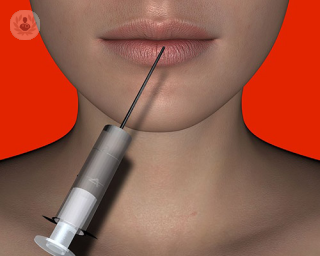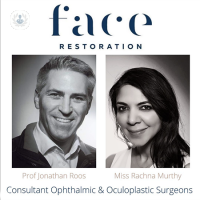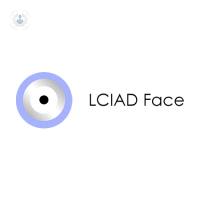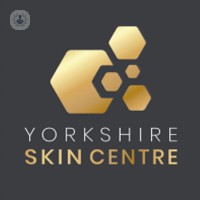What are dermal fillers?
Dermal fillers are one of the most popular treatments used in cosmetic surgery in this day and age, due to the pleasing results they offer without the need to undergo a surgical intervention. The results are achieved by non-invasive techniques, with no risks or secondary effects.

The fillers are used to eliminate wrinkles and deep facial folds, volume replenishment, or simply to rejuvenate and revitalise the skin. The infiltrations consist of hyaluronic acid, polycaprolactone threads, polylactic acid, calcium hydroxyapatite and tricalcium phosphate, collagen, or fat fillers.
All fillers are applied under local anaesthesia, and can be applied as a complement to other treatments, such as facial surgery or botulinum toxin.
Why would you do it?
Dermal fillers are used to rejuvenate and revitalise the skin on the face. The different types of infiltrations help skin recover its natural feel and also restore ageing signs. This is achieved by recovering lost volume, highlighting cheeks or cheekbones, and eliminate wrinkles and facial folds.
The fillers help to reduce the loss of tissue elasticity that manifest as a consequence of ageing by getting rid of of sagging skin, loosened skin, and a lack of facial skin firmness.
What do dermal fillers involve?
There are various techniques using different filling material infiltrations, which are used depending on the area to be treated, such as the type of wrinkle, the location or the depth.
- Tunnelling technique: the needle is inserted toin the skin and, through applying a product at the same time, the needle is removed.
- Point technique: used for more difficult areas such as dark circles around the eyes, cheekbones, and temple.
- Stretching technique: only one injection point is made to allow changing of the direction of the needle, in order to inject with ease and accuracy.
How can you prepare for a dermal filler?
Before undergoing this treatment, your doctor will explain exactly what is involved and set adequate expectations. There is no specific preparation required.
What does recovery involve?
Dermal fillers are also popular as they pose minimal risk, and the main concern after the procedure is the local inflammation reactions that can appear after the treatment, such as irritation or pressure. However, these symptoms are only temporary.
11-13-2012 02-23-2024Dermal fillers
Dr Rachna Murthy - Ophthalmology
Created on: 11-13-2012
Updated on: 02-23-2024
Edited by: Conor Lynch
What are dermal fillers?
Dermal fillers are one of the most popular treatments used in cosmetic surgery in this day and age, due to the pleasing results they offer without the need to undergo a surgical intervention. The results are achieved by non-invasive techniques, with no risks or secondary effects.

The fillers are used to eliminate wrinkles and deep facial folds, volume replenishment, or simply to rejuvenate and revitalise the skin. The infiltrations consist of hyaluronic acid, polycaprolactone threads, polylactic acid, calcium hydroxyapatite and tricalcium phosphate, collagen, or fat fillers.
All fillers are applied under local anaesthesia, and can be applied as a complement to other treatments, such as facial surgery or botulinum toxin.
Why would you do it?
Dermal fillers are used to rejuvenate and revitalise the skin on the face. The different types of infiltrations help skin recover its natural feel and also restore ageing signs. This is achieved by recovering lost volume, highlighting cheeks or cheekbones, and eliminate wrinkles and facial folds.
The fillers help to reduce the loss of tissue elasticity that manifest as a consequence of ageing by getting rid of of sagging skin, loosened skin, and a lack of facial skin firmness.
What do dermal fillers involve?
There are various techniques using different filling material infiltrations, which are used depending on the area to be treated, such as the type of wrinkle, the location or the depth.
- Tunnelling technique: the needle is inserted toin the skin and, through applying a product at the same time, the needle is removed.
- Point technique: used for more difficult areas such as dark circles around the eyes, cheekbones, and temple.
- Stretching technique: only one injection point is made to allow changing of the direction of the needle, in order to inject with ease and accuracy.
How can you prepare for a dermal filler?
Before undergoing this treatment, your doctor will explain exactly what is involved and set adequate expectations. There is no specific preparation required.
What does recovery involve?
Dermal fillers are also popular as they pose minimal risk, and the main concern after the procedure is the local inflammation reactions that can appear after the treatment, such as irritation or pressure. However, these symptoms are only temporary.


Polynucleotides: a comprehensive guide
By Dr Ariel Haus
2024-11-21
Polynucleotides are an injectable serum used to reduce wrinkles, diminish crepiness, scars, and brown spots, tighten pores, and reduce stretch marks on the body. Renowned dermatologist Dr Ariel Haus explains more about the treatment, including how they differ from similar treatments and how long it takes to see the results. See more


What is the difference between Botox and dermal fillers?
By Mr Kambiz Golchin
2024-11-21
What is Botox? What are dermal fillers? What is the difference between the two? Find out in this guide to two of the most popular cosmetic treatments available from top doctor Kambiz Golchin. See more


Dermal fillers vs Botox: which is the better option for me?
By Dr Anne Gormley
2024-11-21
Dermal fillers are primarily used to volumise the face, which in turn slows down the aging process. Non-permanent Hyaluronic Acid (H.A) is the most common dermal filler used by cosmetic clinicians. The dermal fillers contain genetically modified hyaluronic acid, which are differentiated by their consistency. See more


Choosing the right facelift: An expert guide
By Ms Monica Fawzy
2024-11-20
Revered consultant plastic surgeon Ms Monica Fawzy gives expert advice on what to consider when deciding which facelift procedure is right for you in this informative article. See more
Experts in Dermal fillers
-
Dr Julian De Silva
Plastic surgeryExpert in:
- Oculo-facial plastic and cosmetic surgery
- Blepharoplasty
- Facelift
- Rhinoplasty (nose job)
- Dermal fillers
- Neck lift
-
Dr Jacqueline Lewis
Aesthetic medicineExpert in:
- Dermal fillers
- Microneedling
- Exosome treatment
- Botulinum toxin (Botox™)
- Non surgical nose job
- Wrinkles on the lip
-
Mr Fateh Ahmad
Plastic surgeryExpert in:
- Botulinum toxin (Botox™)
- Facial plastic surgery
- Breast surgery
- Body contouring
- Skin cancer
- Dermal fillers
-
Dr Ariel Haus
DermatologyExpert in:
- Botulinum toxin (Botox™)
- Skin cancer
- Anti-ageing treatments
- Acne
- Cosmetic dermatology
- Dermal fillers
-
Dr Hiba Injibar
DermatologyExpert in:
- Dermal fillers
- Rosacea
- Acne
- Melasma
- Botulinum toxin (Botox™)
- Platelet-rich plasma
- See all

Face Restoration
Face Restoration
Phoenix Hospital Group, 9 & 25 Harley St, London W1G 9QY
No existe teléfono en el centro.
By using the telephone number provided by TOP DOCTORS, you automatically agree to let us use your phone number for statistical and commercial purposes. For further information, read our Privacy Policy
Top Doctors

LCIAD Face
LCIAD Face
28 Wimpole Street, W1G 8GW
No existe teléfono en el centro.
By using the telephone number provided by TOP DOCTORS, you automatically agree to let us use your phone number for statistical and commercial purposes. For further information, read our Privacy Policy
Top Doctors

Yorkshire Skin Centre
Yorkshire Skin Centre
1 Sizers Court, Yeadon
No existe teléfono en el centro.
By using the telephone number provided by TOP DOCTORS, you automatically agree to let us use your phone number for statistical and commercial purposes. For further information, read our Privacy Policy
Top Doctors
-
Face Restoration
Phoenix Hospital Group, 9 & 25 Harley St, London W1G 9QY, W1G Marylebone LondonExpert in:
- Blepharoplasty
- Eyelid surgery
- Facial aesthetics
- Laser
- Skin rejuvenation
- Dermal fillers
-
LCIAD Face
28 Wimpole Street, W1G 8GW, Central LondonExpert in:
- Dermatology
- Clinical Dermatology
- Cosmetic Dermatology
- Facial aesthetics
- Facelift
- Platelet-rich plasma
-
Yorkshire Skin Centre
1 Sizers Court, Yeadon, LeedsExpert in:
- Dermatology
- Clinical Dermatology
- Cosmetic Dermatology
- Facial aesthetics
- Most viewed diseases, medical tests, and treatments
- Hormone therapy
- Migraine
- Nutrition
- Weight loss injections
- Endermologie
- Genetic testing
- Polynucleotides
- Endovenous laser treatment (EVLA)
- Minimal access surgery (keyhole surgery)
- Head and neck cancer








